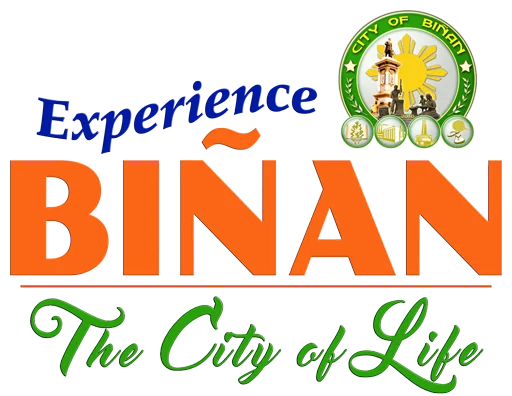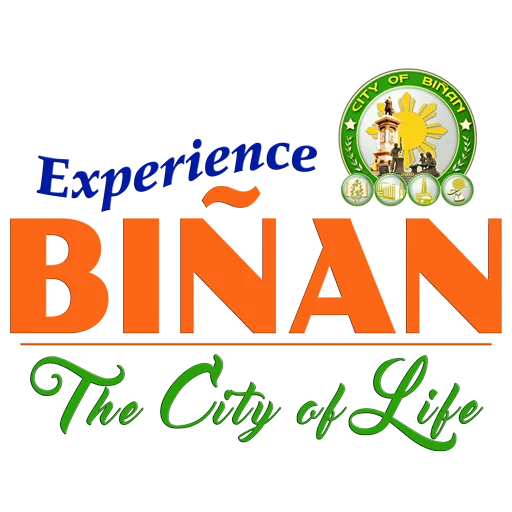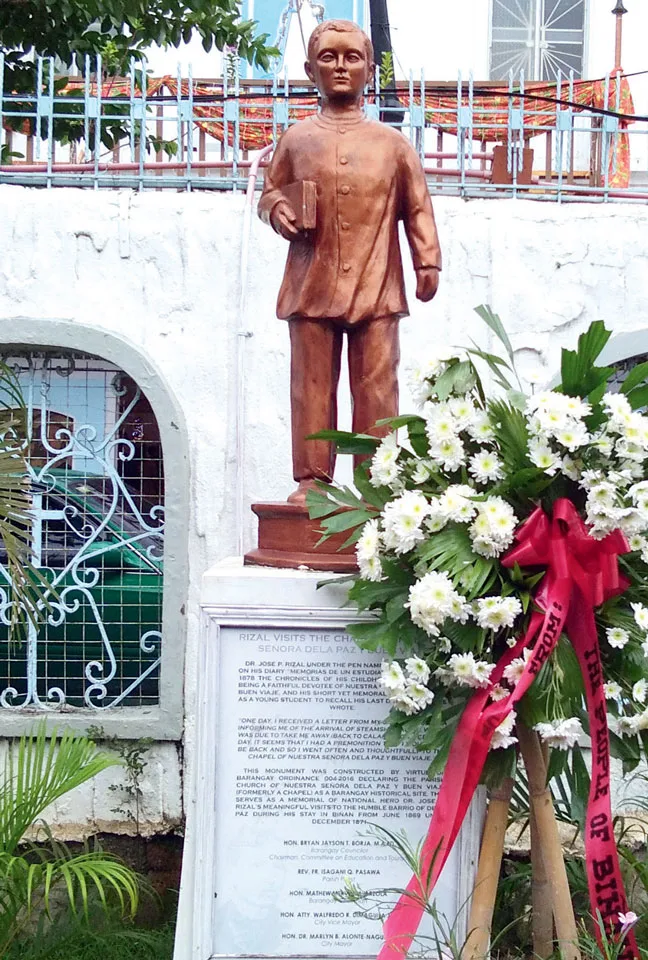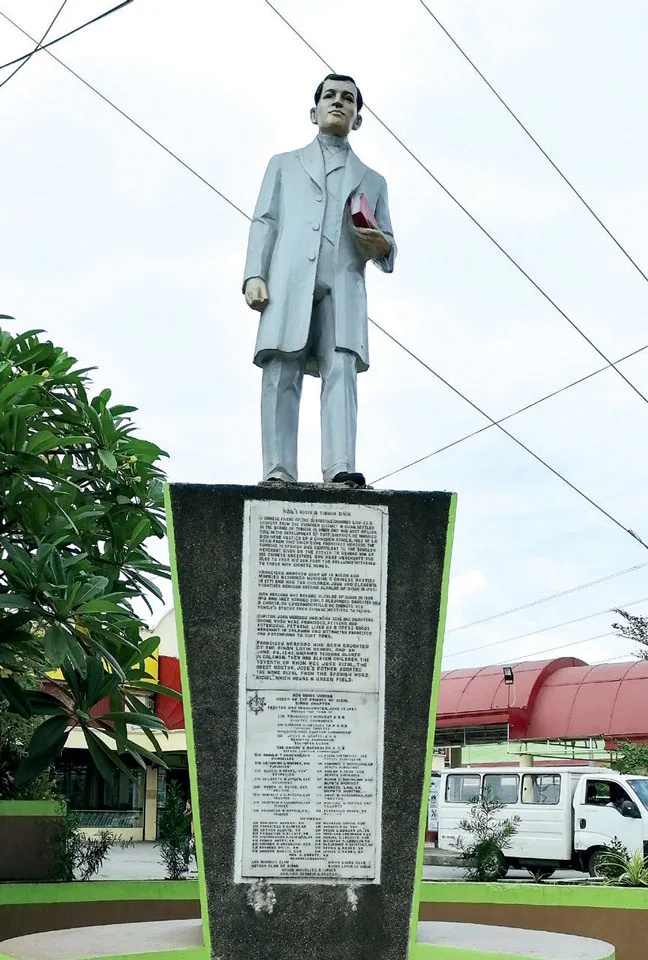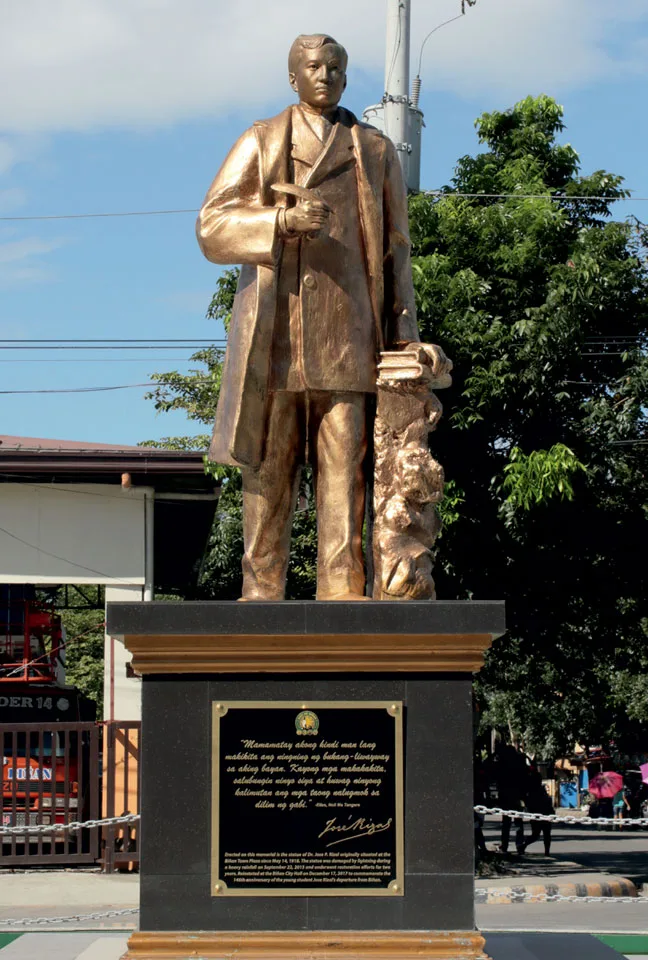Rizal in
Biñan
A Part of Jose Rizal’s Childhood
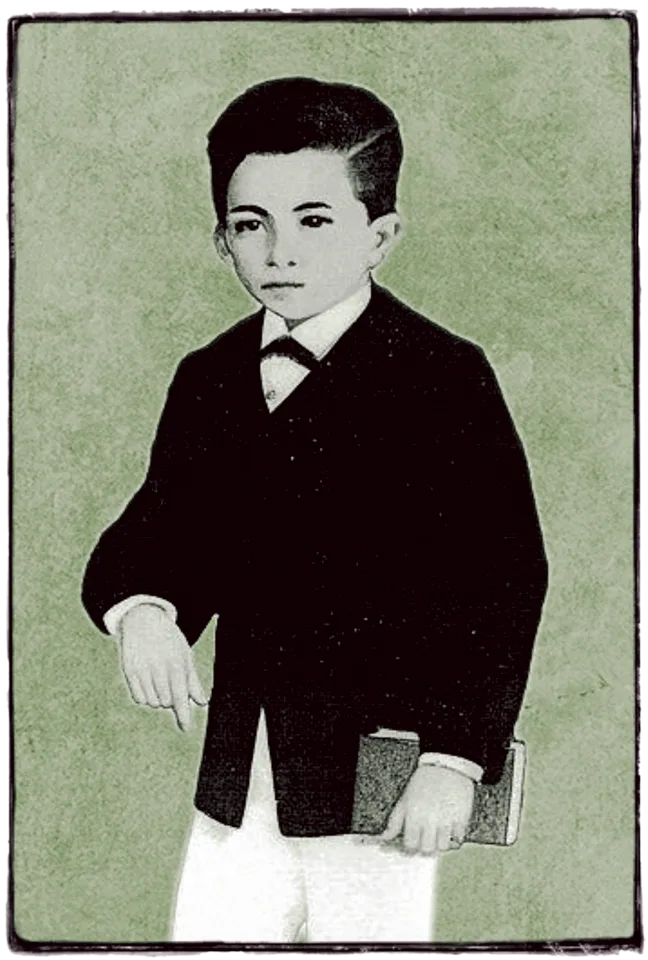
One of the many things that Biñan could be proud of is the fact that it became a part of the national hero’s formative years. Young Jose Rizal, accompanied by his brother, Paciano, came to Biñan in June 1869 to study under Maestro Justiniano Aquino Cruz. Maestro Cruz taught him Latin and Spanish. Rizal excelled in his academic studies. He was at the top of his class, beating all the Biñan boys. While in Biñan, Rizal also took painting lessons under Juancho Carrera, Maestro Cruz’s father-in-law. After one and a half years of tutelage, Maestro Cruz advised the young Rizal to continue his education in Manila.
Aside from his education-related affiliation to the town, Rizal was a Biñanense because both his parents were Biñanenses. Rizal’s father, Francisco Engracio Mercado, was born and raised in Biñan. Both Francisco’s father (Juan Mercado) and grandfather (Francisco Mercado) became capitan of Biñan. And Rizal’s mother, Teodora Alonso, was the daughter of Lorenzo Alonso de Alberto who also became a capitan of the town. Teodora’s grandfather, Cipriano Alonso, had also been a capitan of Biñan twice.
Today, at the center of Biñan’s plaza, a monument of Dr. Jose Rizal stands in recognition of the fact that Biñan, aside from being the place of his family’s roots, had also been a part of the national hero’s childhood. The monument was finished on May 14, 1918 during the incumbency of Mayor Agustin Gana who later became the governor of Laguna. The monument got struck by a lightning and was damaged on September 22, 2015 but it has been restored and now stands in front of the Biñan City Hall in Zapote.
Other structures of Rizal in Biñan include his monument at the Biñan Elementary School, and the Young Rizal Monument installed at the former Dela Paz Chapel site that was duly declared by the Sangguniang Barangay ng Dela Paz and Sangguniang Panglungsod ng Biñan as a Local Historical Site. Rizal frequently visited the chapel during his stay in Biñan as a young student, being a devotee of Nuestra Señora de la Paz y Buen Viaje.
There is also a national historical marker at the actual site of Rizal’s first formal schooling in Biñan (1869-1871) under Maestro Justiniano Aquino Cruz that was installed by the Philippines Historical Committee in 1948.
The Rizal Monument in Barangay Tubigan, unveiled by the Knights of Rizal Biñan Chapter, was also built to memorialize Rizal’s ancestry via the Domingo Lamco bloodline. Domingo Lamco was Rizal’s great great grandfather and was responsible for the “patubig system” in the town.
The Birth of a Hero
Dr. José Protacio Rizal Mercado y Alonso Realonda, “Pepe” as he was affectionately called, was born in the lakeside town of Calambá, Laguna, on 19 June 1861, a few days before the full moon. Because of his large head, his mother almost died during the delivery. “It was a Wednesday, and my coming out in this valley of tears would have cost my mother her life had she not pledged to the Virgin of Antipolo [Nuestra Señora de la Paz y Buen Viaje] to carry me to her sanctuary by means of pilgrimage”, Rizal wrote years later in his memoir Memorias de un Estudiante de Manila.
To better understand the life of Rizal, it is important to dig deeper into his lineage, tracing his roots from generation to generation in order to comprehend hnis character, how he lived, as well as to grasp the milieu he dwelt upon.
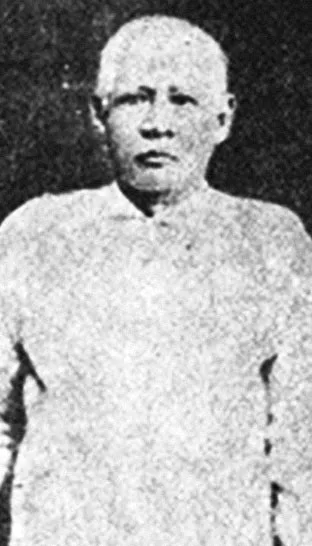
Rizal’s Paternal Lineage
Travelling back to the village of Sionque in Chinchew (or Changchow district in Fujian, Southern China) would acquaint us with the root of Rizal’s paternal lineage. Lam-Co (柯仪南), his Chinese great-great-grandfather, was the son of Siang-co and Zun-nio who lived in the village near the prosperous and ancient trading port of Zaiton. Lam-Co’s name in English means “Lam, Esquire”. He later migrated to the Philippines and arrived in Manila about 1690.
In 1697, Lam-co became a Christian. He was baptized at the San Gabriel Church in the predominantly Chinese community of Binondo, Manila at the age of 35. He assumed “Domingo” as his first name on his baptismal day. He married a Chinese mestiza named Inés de la Rosa who was said to be half his age. Inés was the daughter of Agustín Chin-co and Jacinta Rafaela who belonged to an entrepreneurial family in Binondo.
The relationship of Domingo Lam-co with two Spanish friars, namely, Fr. Francisco Márquez and Fr. Juan Caballero, led to his settlement at the Dominican hacienda or estate of San Isidro Labrador in Biñán, Laguna. He and his family lived in Biñán along with other Chinese immigrants. It was said that Lam-co had been instrumental in the construction of the irrigation works in the area where they resided (presently known as Barangay Tubigan). The site became the richest part of the estate during that time.
In 1731, Lam-co adopted the surname “Mercado”, a Spanish word which in English means “market”. It happened to be quite appropriate then because many ethnic Chinese were merchants, most of whom adopted the same surname. Lam-co and Inés de la Rosa bore a son in the same year. They named him Francisco Mercado – a sign of gratitude to another friar of the same name, Fr. Francisco Mercado, a Spanish mestizo renowned for botanical studies who was also the provisor of the bishop of Nueva Segovia (now Ilocos Sur).
In 1771, Francisco Mercado married Bernarda Mónica who was a native of the nearby hacienda of San Pedro Tunasán (now the City of San Pedro). They had two sons named Juan and Clemente. Francisco settled his family at the hacienda of San Juan Bautista (now the City of Calambá) for a short period of time. However, due to the hostility toward the Chinese immigrants and natives of Chinese descent – a backlash from the British invasion in Manila in 1762, he decided to return his family back to Biñán.
Francisco owned the largest herd of carabaos in Biñán. He also became active in local politics and was elected as the town’s capitán del pueblo around 1783. Being popular and friendly led him to stand as godfather during baptisms and weddings, as revealed in Biñán’s church records. He died in 1801.
Juan Mercado, son of Francisco and Bernarda, married Cirila Alejandro who hailed from Tubigan. They had 13 children, one of whom was also named Francisco who was born on 11 May 1818; he would later become the father of our country’s foremost national hero and Biñán’s most illustrious son, Dr. José P. Rizal.
Following the footsteps of his father Francisco, Juan Mercado became Biñán’s capitán del pueblo in the years 1808, 1813, and 1823. On many occasions, he had been chosen as the hermano mayor for religious and social affairs. His townmates referred to him as “Capitán Juan”.
Capitán Juan died when his son Francisco Engracio Mercado was only eight years old. Since then, Francisco and his siblings helped their widowed mother Cirila in managing the family business.
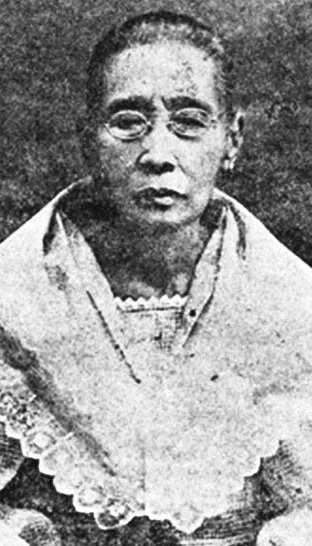
Rizal’s Maternal Lineage
Tn contrast to the ease of tracking down the roots of Francisco Engracio Mercado, the lineage of Teodora Alonso Realonda, Rizal’s mother, is not so easily traced. First in the family line of Teodora’s maternal lineage was said to have been Policarpio Ochoa. He had a son named Estanisláo Manuel Ochoa, part owner of the hacienda of San Francisco de Malabón. There was a story that somewhere in this family was a beautiful lady named Mariquita Ochoa who charmed a Spanish nobleman whom she later married. One of their children was Regina Ochoa who later married a law graduate from the Universidad de Santo Tomás named Manuel de Quintos who comes from a family of Chinese mestizos from Pangasinán. From their wedlock came Joaquín and Brígida de Quintos.
Teodora’s paternal lineage was recorded starting from Capitán Gregorio Alonso of Santa Cruz, Manila. Gregorio had a son named Cipriano Alonso who became capitán del pueblo of Biñán in 1797. Cipriano married María Alejandro who was the daughter of Mariano Alejandro of Biñán and Faustina Florentino of Ilocos. From Cipriano and María’s union came Lorenzo Alberto, Isabel (later Mrs. de Sánchez), and a still unidentified priest. Lorenzo Alberto was first married to an Ilocana named Paula Florentino in 1814. Many years later, he became acquainted with Brígida de Quintos while he was studying in Manila. They had five children: Narcisa, Teodora, Gregorio, Manuel, and José who were all born in Manila but raised in Calambâ. Lorenzo Alberto was a surveyor, and by the year 1824, he became the capitán del pueblo of Biñán. In 1849, in compliance with Governor Narciso de Clavería’s decree ordering Filipinos to adopt Spanish surnames, Lorenzo Alberto adopted “Realonda” to the family surname.
Lorenzo and Brígida’s second child, Teodora Alonso, was born in Meisic, Tondo on 9 November 1827. Coming from a well-to-do family, Teodora had her formal schooling at the Colegio de Santa Rosa in Manila. Teodora grew up to become a well-educated and highly cultured lady.
Matrimonial Union of Rizal’s Parents
In 1848, a year before the Clavería’s decree, the 20-year-old Teodora Alonso married Francisco Mercado. They settled in Calambá, Laguna and to them were born eleven children: Saturnina, Paciano, Narcisa, Olimpia, Lucia, María, José, Concepción, Josefa, Trinidad, and Soledad.
Doña Teodora was known for being a disciplinarian as well as a dedicated, courteous, and hard-working mother. She was Rizal’s first teacher. As a tutor, she was patient, conscientious, and understanding. It was she who first discovered her son’s talent for poetry. Accordingly, she encouraged him to write poems. She had a profound influence on Rizal’s development and was his inspiration in taking up medicine (bolstered by her failing eyesight).
On the other hand, Don Francisco was a firm and independent-minded man who talked less but worked more. He had a strong body and valiant spirit. In his memoirs, Rizal affectionately called him “a model of fathers”.
In 1849, Don Francisco added “Rizal” to the family surname to comply with the aforementioned Clavería decree. Rizal came from the Spanish word “ricial” which connotes a field where wheat, cut while still green, sprouts again.
Following his parent’s death, Don Francisco moved his family to Calambâ. He became a tenant-farmer and managed the Dominican-owned hacienda there. Aside from farming the hacienda leased to them by the said friar order by growing sugar cane, rice, and indigo, he also partitioned the lands and subleased them to Calambeño furthers, thus further augmenting his fortune. He also started a mixed orchard and engaged in poultry. That is why during their time, Don Francisco’s family became one of the wealthiest, if not the wealthiest, in all of Calambâ.
The Rizal Family in Biñan
Francisco Mercado and Biñan
Domingo Lam-co, Don Francisco Engracio Mercado’s Chinese greatgrandfather, had been influential to Biñán and to its people. Lam-co was instrumental in the construction of the Biñán hacienda’s irrigation system (located in what is now known as Barangay Tubigan). From Rizal’s paternal lineage came two capitanes del pueblo: Francisco Mercado (Lam-co’s son) and Juan Mercado (Lam-co’s grandson). They both served with dignity and were loved by their people, actively present during various religious and social occasions in town.
Biñán was the birthplace of Francisco Engracio Mercado who was born on 11 May 1818. It is also where Francisco first studied Latin before he went to Colegio de San José in Intramuros to further study Latin and Philosophy.
Tedora Alonso and Biñan
Biñan played an important role in the life of Rizal’s mother and her family. From her lineage came two capitanes del pueblo of Biñán – Cipriano Alonso and Lorenzo Alberto, all of whom had conscientiously served their townspeople. Teodora grew up and spent her maiden days within the great confines of the Alonso residence, now known as the Alberto Mansion of Biñán.
But it was also in Biñán where she had a harrowing experience, an event which also scarred the young Rizal for life. It was said that Teodora had a half-brother named José Alberto (other books say that he was either a cousin, brother, or stepbrother) whose wife, also named Teodora (Formoso was her maiden name), was accused of having an affair with another man. When José Alberto went to Europe, his wife left home to be with her paramour. The marriage was about to be ruined because of this scandal if not for Teodora’s intervention who did everything she could to reconcile the couple. But instead of repaying Teodora’s moral influence and concern for her family, José Alberto’s wife instead accused the husband of poisoning her, with Teodora as an accomplice.
But there is another version to this story. One day, while José Alberto was away on a trip, Don Lorenzo Alberto had to lock up Teodora Formoso inside a room to keep her from joining her paramour. Teodora Alonso was tasked to feed her. But the unfaithful wife was able to smuggle out a letter to the authorities and even accused Teodora Alonso of poisoning her. José Alberto’s wife filed charges; Don Lorenzo and Teodora were both found guilty. Both father and daughter were imprisoned.
At any rate, whichever version is correct, the end result was the same: Rizal’s mother was punished. She was made to walk from Calambâ all the way to Santa Cruz where her prison cell awaited her. She was incarcerated for more than two years. This event made a lasting impact on the young mind of Rizal. Since then, he had become cynical of authority.
Siblings of José Rizal and Biñan
Biñan was also a part not only of Rizal’s life but also of his siblings. For instance, before Rizal went to study in Biñán, his brother Paciano first stayed there to study Latin under the tutelage of Maestro Justiniano Aquino Cruz (who later became Rizal’s teacher). His sister María, on the other hand, married a Biñanense, Daniel Faustino Cruz. From their marriage came Prudencio, Paz, Mauricio (said to be Rizal’s favorite nephew), Encarnación, and Petrona.
José Rizal’s Early Education
Rizal received his early education in the towns of Calambâ and Biñán. Reading, writing, arithmetic, and religion were all part of a typical schooling for a son of an ilustrado family at that time. The instructions were harsh and rigid. The laborious memory method, aided by the teacher’s whip, was used to push knowledge into the pupils’ heads. Rizal was able to obtain the requisite schooling to prepare for college in Manila. Rizal, who was born physically feeble, grew up to become an intellectual giant.
Rizal’s First Teacher
In many history books, Doña Teodora is credited as Rizal’s first teacher. She was a great woman of high reputation and fine culture. Rizal learned the catón (reading primer) and prayers from her lap when he was only three years old. “My mother taught me how to read and say haltingly the humble prayers which I raised ardently to God,” José wrote in his memoirs. She was a kind, thorough, and understanding tutor. She was the one who first noticed her son’s flair for poetry. She encouraged him to write poems as a result. She told several stories related to the alphabet to break up the monotony of learning it and to encourage her son’s imagination.
José’s parents hired private tutors to teach him at home as he grew older. Maestro Celestino and Maestro Lucas Padua were among them. Later, an elderly gentleman named León Monroy, a former classmate of José’s father, undertook the tutorship. José was taught Spanish and Latin by this old teacher who lived at the Rizal house. Unfortunately, he did not have a lengthy life. Don Francisco and Doña Teodora then consulted Paciano about his younger brother’s education, and it was him who decided that José needed more formal schooling. At that time, Biñán was well-known for its private school. Following Monroy’s death, the Mercado couple decided to send their youngest son to a private school in their hometown for him to pursue further studies in Latin.
Rizal in Biñán: The Hero’s First Formal Education
Biñan was also a part not only of Rizal’s life but also of his siblings. For instance, before Rizal went to study in Biñán, his brother Paciano first stayed there to study Latin under the tutelage of Maestro Justiniano Aquino Cruz (who later became Rizal’s teacher). His sister María, on the other hand, married a Biñanense, Daniel Faustino Cruz. From their marriage came Prudencio, Paz, Mauricio (said to be Rizal’s favorite nephew), Encarnación, and Petrona.
In June 1870, the nine-year-old José Rizal was sent by his father to Biñán to have his first formal education. José was accompanied by Paciano, then nineteen, in a carromata (horse-drawn carriage), a trip that took about an hour and a half passing through the towns of Cabuyao and Santa Rosa. It was almost nighttime when they reached the house of their Tía Tomasa Mercado, where the younger Rizal was to stay for the duration of his studies. He shared his aunt’s home with two cousins (Margarita and Gabriel), two nieces (Arcadia and Florentina), and a nephew (Leandro, a cousin’s son). In his memoirs, he described his aunt as an elderly woman who must have been over seventy years old. She had a tendency of reclining on the floor and reading the Bible in Tagálog. Margarita Itag, his cousin, was unmarried and very fond of admitting her mistakes and performing penance for them. Gabriel, Margarita’s brother, was a widower. Arcadia, a young tomboy with a tough personality and a quick temper, had a simple and open heart. Florentina, on the other hand, was a young girl with obnoxious characteristics. Lastly, Leandro was a darling youngster, spoiled, flattering when it suited him, intelligent, and scalawag in every meaning of the word. José went for a walk around town with Leandro on his first night in Biñán. Rather than enjoying his first stroll through town, he grew unhappy due to homesickness. “I remembered my hometown, my revered mother, and my solicitous sisters in the moonlight,” he wrote. One day, his nephew Leandro played a fatal prank on him by pushing him into the Biñán River while they were bathing on a stone landing along its banks. The stone landing was only a few steps away from his aunt’s house. Rizal was afraid to bathe in the river, finding it too deep for him. This provoked the naughty Leandro to push him into the water. Rizal would have drowned if someone hadn’t seized him by the feet as the river current was already carrying him away. This earned Leandro a stiff reprimand from his grandaunt Tomasa, not to mention numerous slipper slaps.
Rizal’s first day in school. The next morning, Paciano took his younger brother to the school of Maestro Justiniano Aquino Cruz. The school was located at the teacher’s house, a small nipa hut about 30 meters away from the house of Rizal’s aunt. To get there, one had to walk down a short street and around a tree-shaded corner. It was surrounded by a lot of greenery. It had a rock foundation and natural brown-colored wooden walls similar to a bahay na bató. However, like a nipa hut, its roof was covered with pauid (palm leaves). It had large, open windows that were ideal for the tropics.
Paciano knew the teacher quite well because he had previously studied under his tutelage when he was in Biñán. He then left to return to Calambá after introducing his young brother to the teacher.
José was given his seat in the class right away. He was asked by his teacher:
“Do you know Spanish?”
“A little, sir.” the Calambeño lad replied.
“Do you know Latin?”
“A little, sir.”
José’s responses were met with laughter from the boys in the class, particularly from Pedro, the teacher’s son. The teacher abruptly stopped them to begin the day’s lessons.
In his memoirs. Rizal described Maestro Justiniano as follows: “He was tall, thin, long-necked, with sharp nose and a body slightly bent forward, and he used to wear a sinamay shirt, woven by the skilled hands of the women of Batangas. He knew by heart the grammars of Nebrija and Gainza. Add to this his severity that in my judgement was exaggerated and you have a picture, perhaps vague, that I have made of him, but I remember only this.”
Rizal’s first school fight. José encountered the bully Pedro in the afternoon of his first day in school while the teacher, Pedro’s father, was taking his siesta (afternoon nap, a common Hispanic practice). He was already furious with Pedro for making fun of him during the morning interview with the teacher. The teasing continued. But noticing that José was unperturbed, Pedro challenged him to a fight, believing that he could defeat the Calambá lad who was smaller and younger. José immediately accepted. The two boys fought ferociously against each other, much to their classmates’ delight. But José was able to conquer his bigger tormentor, for he learned the skill of wrestling from his athletic Tío Manuel. He thus earned the respect of his classmates as a result of this feat.
Another classmate, Andrés Salandanan, challenged José, this time to an arm wrestling competition. José, who lacked a stronger arm, fell from the table and nearly hit his head on the pavement. He had more battles against some of his Biñán classmates in the days that followed. He wasn’t naturally a quarrelsome person, yet he never shied away from a fight.
Rizal’s daily life in Biñán. José lived a simple and methodical life in Biñán. His future development was greatly aided by such way of daily life. It bolstered both his physical and spiritual well-being. In his memoirs, he spoke of his everyday life in Biñán:
I heard the four o’clock Mass (in the morning), if there was one; or I studied my lessons at the same hour and heard Mass afterward. Upon returning, I looked for a mabolo fruit in the grove and I ate it. Afterward I took my breakfast, which consisted usually of a plate of boiled rice, and two fried sardines. Then I went to class, which was over at ten. I went home immediately.
If there was a particularly appetizing fish, Leandro and I were told to take it to the house of my aunt’s son (a thing which I never did at home, and would never have done). I returned without saying a word, ate with them, and then applied myself to my studies.
I went back to school at two, and was out at five. I played for a while with some good cousins before going to home. There I studied my lessons, doodled a little, afterward taking my supper of one or two plates of boiled rice and an ayuñgin. We said our prayers and then, if there was a moon, my friends would call me out to play in the street in company with others. Thanks to God, I never fell sick when I was away from my parents.
He visited his family in Calambá every now and then while he was studying in Biñán. Nevertheless, the road connecting the two towns seemed very long to him, and his brief visits to his parents and siblings seemed very fleeting. Whenever he went home to Calambá, a secret delight flooded his chest when the tiled roof of his house could already be seen from afar. He also looked for excuses to stay longer at home. But whenever the calesa that was to return him to Biñán arrived, he would grieve silently. He was, after all, still a child. Rizal’s painting lessons. In Biñán, he also learned the painting under the tutelage of an elderly painter named Juancho Carrera. Juancho, whose house is near the school, was the father-in-law of Maestro Justiniano. Drawn by his passion for painting, José spent many spare hours at the painter’s studio. Juancho generously taught him how to draw and paint. He was awestruck by the young Rizal’s creative ability.
Rizal and José Guevarra, a classmate who also enjoyed painting, became apprentices of the old painter. They improved and perfected their work and became the “favorite painters of the class” over time.
Rizal as a star student. José outshone all the Biñán lads when it came to academics. He outperformed them all in Spanish, Latin, and many other subjects. His academic superiority made several of his elder classmates envious. They screeched incessantly to the teacher anytime José got into a fight outside the school, and they even made lies to discredit him in front of the teacher. As a result, the teacher had no choice except to reprimand him. “In spite of the reputation I had of being a good boy, the day was unusual when I was not laid out on a bench and given five or six blows”, Rizal thus wrote in his memoirs.
José admired his teacher, but he is not very fond of the maestro’s ways. José was a filósofo, a smart aleck who was frequently chastised — perhaps because he was an extraordinarily bright youngster, a genius, or just because he was nurtured by an educated and cultured mother. He couldn’t forget the initial strike of the maestro’s ferule to his hand, a pain he didn’t want to comment and elaborate on. Not to mention the numerous prior times he was caned despite being a top student. He despised the physical punishment despite understanding its disciplinary purpose.
Rizal’s departure from Biñán. José received a letter from his sister, Saturnina, just before Christmas in 1871, informing him of the arrival of the steamer Talim which would transport him from Biñán back to Calambâ. He grew sad after reading the letter because he had a sense that he would not return to Biñán. He prayed frequently in the chapel of Nuestra Señora de la Paz y Buen Viaje (Our Lady of Peace and Good Voyage, now a parish church), collected river pebbles as souvenirs, and bade sad goodbyes to his teacher and classmates.
On the afternoon of 17 December 1871, after a year and a half of stay, he left Biñán with all the memories and learnings he got from the town with him. He was ecstatic to board the Talim because it was his first time aboard a steamer. A Frenchman called Arturo Camps, a friend of his father, was on board to look after him.
The Influence of Biñán in the life and works of
Dr. José P. Rizal
In the arms of his strict but loving mother, Dr. José Rizal lived a joyful life in Calambâ. It was calm and peaceful in comparison to the bustling life in Biñán, which he was not used to. Their home was the first bahay na bató in his hometown, indicating that he had lived a very comfortable life. Biñán, on the other hand, transformed him into a stranger to his own home, which was something he needed and that he missed. His educational experience in Biñán helped him prepare for further studies in Manila and Spain. In sum, his brief but significant stay in the hometown of his parents transformed him into the hero whom we know today. José was never the same after stepping into the bustling town of Biñán. Historian Peter Uckung agrees with National Artist Nick Joaquín that Biñán influenced Rizal to design the town of San Diego as how it was written in his epic novels Noli Me Tangere and El Filibusterismo.
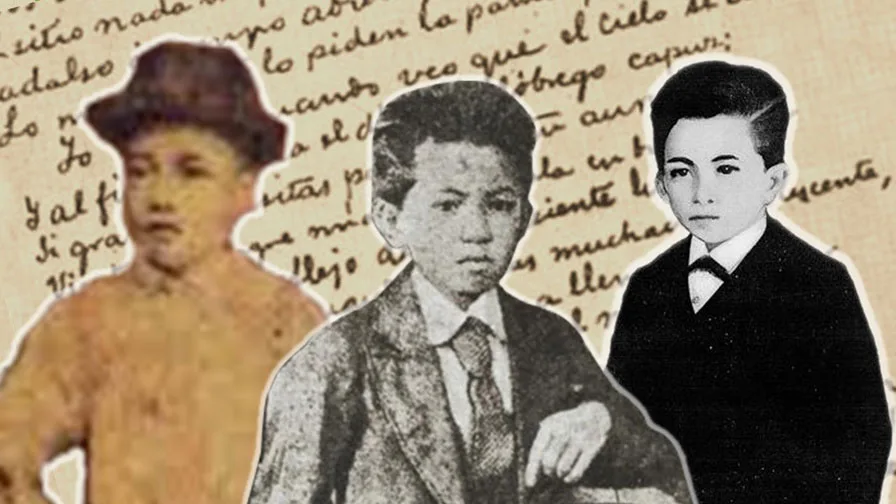
References:
Araneta, G. (1995). Sentimiento: Fiction & Nostalgia / Katha at Salamisim. Pásig, Philippines: Anvil Publishing, Inc.
Arcilla, J. (1970). Calambá Deportations: Notes on the Calambá Estate. Philippine Studies. Quezon City, Philippines. Ateneo de Manila University.
Bantug, A. L. (2008). Lolo José: An intimate and Illustrated Portrait of José Rizal (2nd ed.). Quezon City, Philippines: Vibal Publishing House, Inc.
Blair, E., Robertson, J. (1903). The Philippine Islands, 1493-1803. Vol. 23. Cleveland, OH: A.H. Clark Company.
Boñgon, A. B. (2018). The Mercados of Biñán: Celebrating 200 Years of Rizal’s Father, Honoring Rizal’s Paternal Lineage. The City of Life Magazine (4), p. 17.
City Government of Biñán. (2020). Pamana ng Buhay: The Living Heritage of Biñán. City of Biñán, Laguna, Philippines: City Government of Biñán and Erehwon Artworld Corporation.
Craig, A. (1913). Lineage, Life and Labors of José Rizal, Philippine Patriot. Manila, Philippines: Philippine Education Company.
Guerrero, L. (2007). The First Filipino: A Biography of José Rizal. Manila, Philippines: Guerrero Publishing.
Hernández, J., de Ocampo, E. A., & Ella, Z. C. (1958). José Rizal: The Reformer. Quezon City, Philippines: Kayumanggi Press.
Ma. Guerrero, L. (1951). The Young Rizal. Manila, Philippines: Bardavon Book Company.
National Historical Commission of the Philippines. (2011). José Rizal: Reminiscences and Travels. T.M. Kalaw St., Erminta, Manila, Philippines: National Historical Commission of the Philippines.
Ocampo, A. (1990). Rizal Without the Overcoat (revised ed.). Pásig, Philippines: Anvil Publishing, Inc.
Ocampo, A. (13 June 2010). Secrets locked in Alberto house about Rizal’s mother. The Philippine Daily Inquirer.
Palma, R. (1949). The Pride of the Malay Race: A Biography of José Rizal. (R. Ozaeta, Trans.) Quezon City, Philippines: Ken Incorporated.
Poblete, P. (1909). Buhay at Mga Ginawa ni Dr. José Rizal. G. Neneng Rizal
Rivera, C. C., Landicho, D. G., & Valenciano, D. V. (1969). Rizal: Ang Bayani. Makati, Metro Manila, Philippines: Makati Trade Times Publishing Co., Inc.
Zaide, G. F. (1970). José Rizal: Asia’s First Apostle of Nationalism. Manila, Philippines: Red Star Book Store.
Zaide, G. F. (1971). Rizal: His Travels. Manila, Philippines: Radiant Star Publishing.
